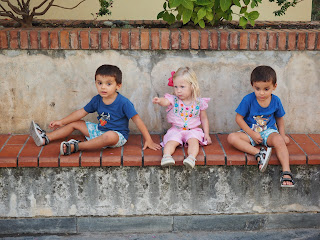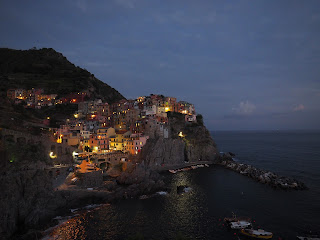September 13, 2018
 |
| Us on the Terrace of the Duomo |
Today was largely a travel day, but first we had to see the most important sight in Milan that we hadn’t managed to get to yet - the Duomo. The Duomo is, far and away, my favorite church in the world (that I’ve seen thus far). Unfortunately, it’s changed a lot since I was last here in 2006. It used to be free, and they left the doors open for anyone to enter at any time. You still had to pay to go up to the terraces, but that was it. Now, however, it’s like a military compound, with armed guards at every entrance. The lines are absurdly long, and you have to pay, just to go in.
Construction on the Duomo began in 1386, but it took more than 600 years to finish! It was dedicated to Santa Maria Nascente, and meant to memorialize the end of the tyrannical Barnabò Visconti’s reign, and the ascension of Gina Galeazzo Visconti. It was also intended to be the seat of the Archbishopric of Milan. Nearly 80 different architects and engineers worked on the project over the course of its life. It’s the largest church in Italy by far, and, depending on the source and criteria being used, the third or fourth largest church in the world. St. Peter’s Basilica (which is in Vatican City, not Italy), is unquestionably the largest. The second is Basilica of the National Shrine of Our Lady in Aparecida, Brazil. The third largest depends on whether you’re measuring internal or external size. The Duomo in Milan is the third-largest by internal size, but the Cathedral in Seville, Spain is quite a bit larger on the exterior, but has a smaller interior.
The most revered relic in the Duomo is il Santo Chiodo (the Holy Nail) - one of the nails used to nail Jesus to the cross. It rests in a tabernacle nearly 150-feet above the altar, and is only brought down once each year during, the Rite of the Nivola. The Rite of the Nivola owes its name not to the nail, but to the cloud-shaped lift that the Archbishop rides up to retrieve the nail during the ceremony. The RIte of the Nivola occurs on September 14 every year, so we just missed seeing it. Having seen it before, however, I can vouch for the fantastic and ethereal ceremony they conduct.
 |
| Saint Bartholomew |
My other favorite piece of art in the Duomo is a statue of Saint Bartholomew, who was flayed alive in 1562. The statue depicts him with his flayed skin draped around his body, with his head over his back. It’s stunning, and I’m pretty sure that the guy who directed Harry Potter modeled Voldemort after this statue.
After spending about an hour admiring the Duomo, we walked up to the terraces to check out the view from the top. The view is ok, but the real draw is the Gothic architecture and the hundreds of gargoyles and figures that adorn the outside of the cathedral. My mom wanted to get a picture at a particularly pretty spot on the terrace, so we were waiting for this Japanese guy(30ish) and his father to finish taking pictures. It was 10:00 a.m., but this guy was wearing a tux shirt (that he had sweated through), with an untied white bow tie, jeans, and black tennis shoes. We thought that they would take a picture or two and move on, but we couldn’t have been more wrong. The dad directed his son to strike all sorts of absurd, pensive poses and took multiple pictures from multiple angles before telling him to strike another pose. Finally, he walked out and we were sure it would be our turn. Nope. The father dropped his bag and they changed places to replicate the ridiculously long photo shoot. When they FINALLY finished, my mom was walking into the corner when a couple (clearly Italian) with a selfie-stick barged in front of her to take their pictures in her spot. Thankfully, we finally got a few good pictures there and moved on.
We wrapped up our tour around 10:30, made a quick stop at the hotel to grab our luggage, and then began the long and arduous trip to Cinque Terre. When we arrived at the train station, I learned that our train had been effectively sold out - there were only two seats left, and we needed six - so we had to delay our departure by about 30 minutes. We passed the time at a small Asian bistro in Centrale, which was surprisingly good.
Our first train was to La Spezia, which is just south of Cinque Terre and, with Levanto, serves as one of the main hubs for travel to the five lands. It was a train to Rome, so we had designated seats and the people on the train were real pills about it. I’ve never had someone demand their assigned seat until today, which resulted in a quite a bit of confusion and frustration as we relocated from one car to the next with all of our luggage in tow. After about three hours, we arrived in La Spezia, made the switch to the Cinque Terre Regional Express, and made the 15-minute trip up to Manarola.
Manarola is the fourth of the five towns in Cinque Terre, when counting from north to south. I booked our hotel there because, to my knowledge, it was the southernmost town connected by open trails. Via dell’Amore - the trail between Manarola and Riomaggiore (the fifth town) has been closed since a major landslide in 2011. Upon arrival, however, we learned that the trail between Corniglia (the third town) and Manarola was also still closed.
 |
| Witten and Her Italian Friends in Manarola |
Manarola, like all of the villages, is on a very steep hill. Luckily, our hotel was right at the bottom of the hill, as soon as we came out of the tunnel to the train station. I couldn’t have asked for a better location. We spent the afternoon exploring Manarola. First up, a wine tasting at a local enoteca. They vintner had six different wines - four white and two red. We were the only people there when we walked in, but the vintner still looked a little panic-stricken when we told him that we wanted to sample all six. He drew on just about all of his English to say that he didn’t know whether he had enough glasses for the five of us to try six wines. Instead, he said that he’d pour us a full glass of each wine, and we could share them. He was in luck, because not more than ten minutes later, his enoteca was packed with people! The white wines were generally pretty good, and one of the reds was solid. The other just lacked much body or flavor. After our tasting, Witten made friends with two twin Italian boys in the piazza outside of the church. The three of them had a blast running around together, until one of them ran square into Witten and almost bowled her over. Then she was done. The boys’ grandmothers were adorable. They kept apologizing and scolding their grandson, telling him that he needed to tell Witten he was sorry and give her a big kiss (in Italian, of course). Then all hell broke loose when someone pointed out that their other grandson was crawling on the wall over a cliff.
 |
| Manarola at Night |
After things settled down, we set off up the hill overlooking Manarola to get a panoramic view of the area, and ended up at a bar built at the most panoramic spot in the city to watch the sunset while drinking some local wines. It was absolutely incredible! Witten fell asleep on Kati’s shoulder at the bar and was DONE! She didn’t wake back up all night, even when we transferred her to her crib.
When we got back to the hotel, Callie found out that her flight home - which was scheduled for Saturday morning out of Florence (the city) - had already been cancelled, because of Florence (the hurricane). We put Witten down, and I set out to get some beverages for the evening. I came back with two craft German beers and a bottle of Sangiovese from Cinque Terre. All three were excellent, and we enjoyed them lounging in our rooms while my dad worked diligently on rebooking Callie on a flight out on Sunday. The benefit of all of this is that Callie gets an extra day in Italy, and can spend some time in Florence with us.